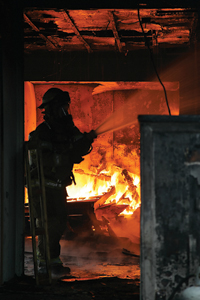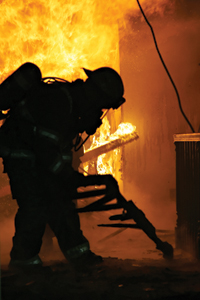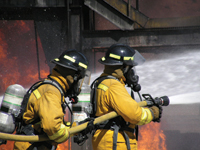
Equipment
Trainer’s Corner: November 2009
Before I launch into this month’s discussion, I would like to express my thanks for your feedback regarding a mayday protocol for the Canadian fire services. It seems that firefighters support a national standard for calling and responding to a mayday, yet the response from provincial fire commissioners and fire chiefs associations is frustratingly slow.
November 6, 2009
By Ed Brouwer
Before I launch into this month’s discussion, I would like to express my thanks for your feedback regarding a mayday protocol for the Canadian fire services. It seems that firefighters support a national standard for calling and responding to a mayday, yet the response from provincial fire commissioners and fire chiefs associations is frustratingly slow. Firefighters are still dying on the fire ground and it may be up to us to instigate the mayday protocol across our nation as an in-house policy. Let no firefighter’s ghost say that his/her training let them down.
Even though today’s firefighters are battling the fire dragon with “new and better” technology, they are still losing their lives to the same old killers (structural collapse, smoke inhalation, heat, getting lost and running out of air). In fact, our new gear lets us venture further into the dragon’s lair, which only complicates matters should something go wrong.

|
|
| It is only during hands-on training while wearing SCBA that firefighters can understand their personal air-consumption rates. | |
 |
Since the dragon has not come up with new ways to kill firefighters, shouldn’t we in the fire service be able come up with counter measures to dramatically decrease line-of-duty deaths in the future?
I know I’m preaching to the choir, but when will we do something about the No. 1 killer of firefighters – heart attacks? Or what about firefighter fatalities from accidents occurring when responding to or returning from an emergency (fire apparatus or private vehicle). Many of these fatalities could be avoided by simply slowing down and wearing seatbelts.
The ball is in our court. We can and, in fact, must deal with the fact that firefighters are not screened adequately for heart conditions and overall heart health and that firefighters are not trained adequately to drive under emergency conditions.
Fighting the dragon inside of a structure is a bit of a different story. Firefighters are dying due to smoke inhalation after getting lost and running out of air, burns due to backdraft or flashover and/or crushing injuries caused by structural collapse.
The following are reasons for firefighters dying in structures: lack of training and experience; poor strategic and tactical leadership; and lack of air management. It is the latter that we will look at here.
Very few of our fire departments monitor their SCBA air supplies on the fire ground. They may have a staging area set up with fresh bottles and a RIT, but very few indeed have an SCBA board indicating time in and out. Even the firefighters themselves are not monitoring their air supplies closely, if at all. Some go in with half-filled bottles, never looking at their personal pressure gauges and simply waiting for their low-air alarms to go off. When the alarm goes off, they may, if it seems urgent, consider exiting the building. Firefighters must leave the IDLH atmosphere before their low-air alarm sounds.
During training, we were instructed (erroneously) not to worry about the low-air alarm going off. Should we find ourselves in a burning, smoke-filled building and run out of air, we were advised to simply disconnect the air supply tube and tuck it into our glove or bunker gear. Breathing this smoke presented an enormous risk to the short- and long-term health of firefighters. Generations of past firefighters have suffered from cancers and pulmonary diseases due to breathing this toxic smoke.
Today’s fires consume contents that are made mostly of synthetics, which produce some of the most dangerous and fatal chemicals known to humankind – chemicals like hydrogen cyanide, polyvinyl chloride, formaldehyde, hydrogen chloride and carbon monoxide.
The Phoenix Fire Department recently completed a study that revealed that a typical room-and-contents fire in a modern structure produces levels of carbon monoxide above 20,000 parts per million (ppm). This is enough carbon monoxide to kill a firefighter in just one or two breaths of this noxious smoke.
 |
|
|
|
If you are a firefighter in a toxic smoke environment the only protection you have is the air on your back. It is of utmost importance that you manage your air effectively. You must leave the IDLH environment before your low-air alarm activates. This leaves a bigger window for the RIT should something go wrong.
It is only during hands-on training while wearing SCBA that firefighters will begin to understand their personal air-consumption rates. It is very important to regularly monitor air usage during training drills. Monitoring air supply needs to become a habit.
The question before each department now is whether your firefighters are exiting the IDLH atmosphere prior to using the SCBA emergency reserve. NFPA 1410 clearly establishes that the low-air alarm indicates the use of the emergency reserve, rather than a time-to-exit alarm.
We all know that it takes time for the efforts of RIT (activation, entry, locating, extracting) to be successful. If NFPA 1404 is not followed and firefighters work until their low-air activates, they significantly reduce their window of survivability.
The easiest way not to become a victim of these deadly smoke products is to manage the air in your SCBA and follow the parameters of NFPA 1404.
Until next time, stay safe and remember to train like their lives depend on it.
Ed Brouwer is the chief instructor for Canwest Fire in Osoyoos, B.C., and the training officer for West Boundary Highway Rescue. The 20-year veteran of the fire service is also a fire warden with the B.C. Ministry of Forests, a wildland interface fire suppression instructor/evaluator and a fire-service chaplain. Contact Ed at ed@thefire.ca
| Is your department complying with NFPA 1404?
Chapter 5 of NFPA 1404 states (in 5.1.4), The Authority having jurisdiction shall establish and enforce written standard operating procedures for training in the use of respiratory protection equipment that shall include the following: 1. When respiratory protection equipment is to be used; 2. Individual air management program; 3. Emergency evacuation procedures; 4. Procedures for ensuring proper face piece fit; 5. Cleaning of respiratory protection equipment components; 6. A policy for changing respiratory filters and cartridges; 7. A policy defining the end of service life for all types of filter or cartridge-type respirators; 8. A policy defining the proper storage and inventory control of all respiratory protection equipment. Appendix 5.1.4 (2) states: This program will develop the ability of an individual to manage his or her air consumption as a part of a team . . . This can require members to rotate positions of heavy work to light work so air consumption is equalized . . . The individual air management should include the following directives: 1. Exit from an IDLH atmosphere should be before consumption of reserve air supply begins; 2. Low-air warning is notification that the individual is consuming the reserve air supply; 3. Activation of the reserve air alarm is an immediate action item for the individual and the team. Putting all this together, we find that you need to be out of the IDLH atmosphere before your low-air alarm activates. This would leave you with 25 per cent of your SCBA bottle (regardless of size or manufacturer). Consider that should your low-air alarm activate and you are not at an exit door or window in 30 seconds, it is considered to be an “immediate action” situation. There are only two other immediate action items: a mayday situation and an activated PASS device. Chapter 5 of NFPA 1404 states (in 5.1.6 and 5.1.7): 1. Identification of the various types of respiratory protection equipment; 2. Responsibilities of members to obtain and maintain proper face piece fit; 3. Responsibilities of members for proper cleaning and maintenance; 4. Identification of the factors that affect the duration of the air supply; 5. Determination of the air consumption rate of each member; 6. Responsibilities of members for using respiratory protection equipment in hazardous atmosphere; 7. Limitations of respiratory protection devices; 8. Battery life limitations and recharging requirements of PAPRs. The 2006 edition requires that firefighters determine the air consumption rate of each member. Appendix 5.1.7(5) states, The air consumption rate will be different for each individual. Some factors that determine the individual’s air consumption rate are as follows: 1. Physical fitness and condition; 2. Size and weight of the individual; 3. Work being performed; 4. Environment where work is being performed; 5. Other stressors (e.g., people trapped, difficult access, outside temperatures); 6. Type of clothing used; 7. Training. |
Print this page